Information about goodwill method - Memo
VerifiedAdded on 2021/02/19
|8
|2599
|58
AI Summary
Contribute Materials
Your contribution can guide someone’s learning journey. Share your
documents today.
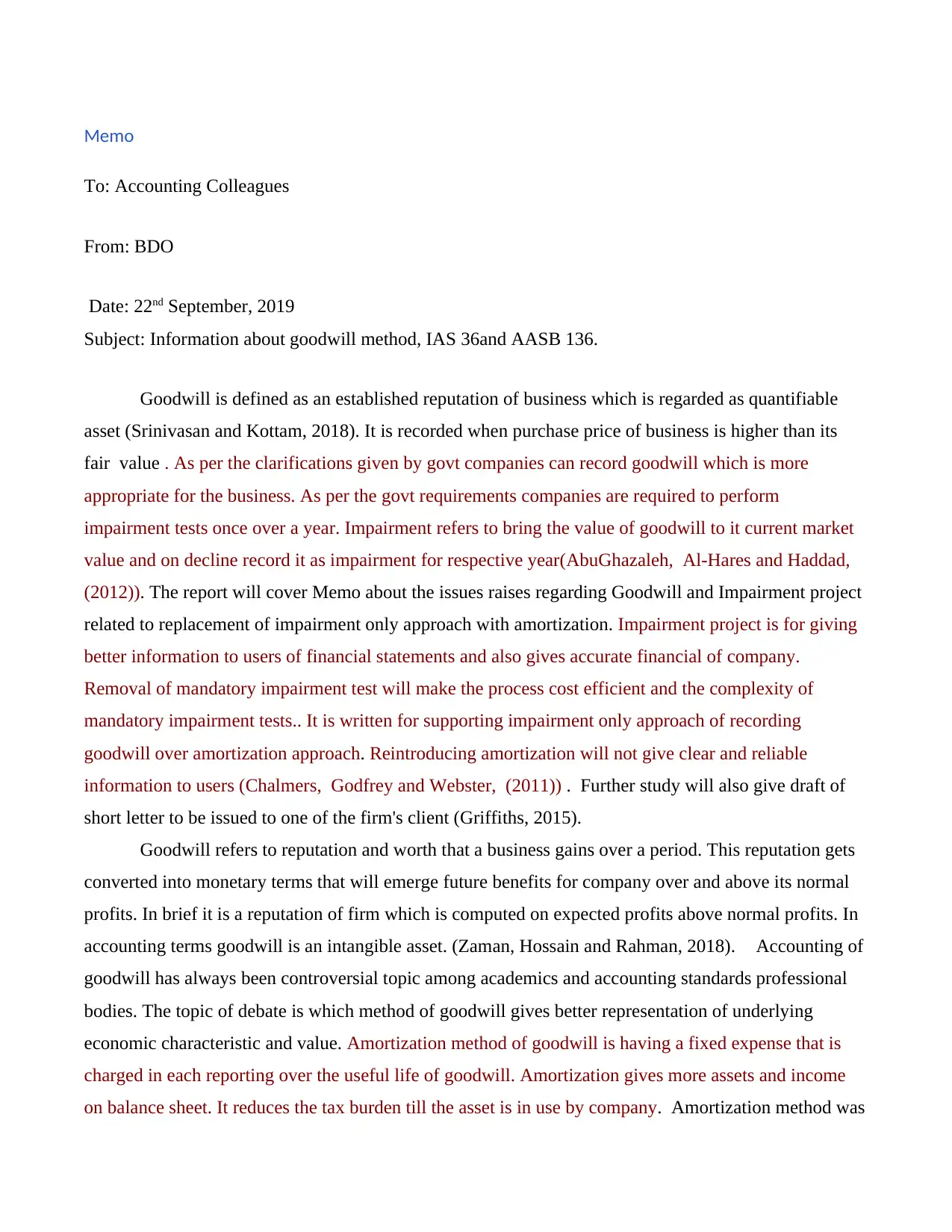
Memo
To: Accounting Colleagues
From: BDO
Date: 22nd September, 2019
Subject: Information about goodwill method, IAS 36and AASB 136.
Goodwill is defined as an established reputation of business which is regarded as quantifiable
asset (Srinivasan and Kottam, 2018). It is recorded when purchase price of business is higher than its
fair value . As per the clarifications given by govt companies can record goodwill which is more
appropriate for the business. As per the govt requirements companies are required to perform
impairment tests once over a year. Impairment refers to bring the value of goodwill to it current market
value and on decline record it as impairment for respective year(AbuGhazaleh, Al-Hares and Haddad,
(2012)). The report will cover Memo about the issues raises regarding Goodwill and Impairment project
related to replacement of impairment only approach with amortization. Impairment project is for giving
better information to users of financial statements and also gives accurate financial of company.
Removal of mandatory impairment test will make the process cost efficient and the complexity of
mandatory impairment tests.. It is written for supporting impairment only approach of recording
goodwill over amortization approach. Reintroducing amortization will not give clear and reliable
information to users (Chalmers, Godfrey and Webster, (2011)) . Further study will also give draft of
short letter to be issued to one of the firm's client (Griffiths, 2015).
Goodwill refers to reputation and worth that a business gains over a period. This reputation gets
converted into monetary terms that will emerge future benefits for company over and above its normal
profits. In brief it is a reputation of firm which is computed on expected profits above normal profits. In
accounting terms goodwill is an intangible asset. (Zaman, Hossain and Rahman, 2018). Accounting of
goodwill has always been controversial topic among academics and accounting standards professional
bodies. The topic of debate is which method of goodwill gives better representation of underlying
economic characteristic and value. Amortization method of goodwill is having a fixed expense that is
charged in each reporting over the useful life of goodwill. Amortization gives more assets and income
on balance sheet. It reduces the tax burden till the asset is in use by company. Amortization method was
To: Accounting Colleagues
From: BDO
Date: 22nd September, 2019
Subject: Information about goodwill method, IAS 36and AASB 136.
Goodwill is defined as an established reputation of business which is regarded as quantifiable
asset (Srinivasan and Kottam, 2018). It is recorded when purchase price of business is higher than its
fair value . As per the clarifications given by govt companies can record goodwill which is more
appropriate for the business. As per the govt requirements companies are required to perform
impairment tests once over a year. Impairment refers to bring the value of goodwill to it current market
value and on decline record it as impairment for respective year(AbuGhazaleh, Al-Hares and Haddad,
(2012)). The report will cover Memo about the issues raises regarding Goodwill and Impairment project
related to replacement of impairment only approach with amortization. Impairment project is for giving
better information to users of financial statements and also gives accurate financial of company.
Removal of mandatory impairment test will make the process cost efficient and the complexity of
mandatory impairment tests.. It is written for supporting impairment only approach of recording
goodwill over amortization approach. Reintroducing amortization will not give clear and reliable
information to users (Chalmers, Godfrey and Webster, (2011)) . Further study will also give draft of
short letter to be issued to one of the firm's client (Griffiths, 2015).
Goodwill refers to reputation and worth that a business gains over a period. This reputation gets
converted into monetary terms that will emerge future benefits for company over and above its normal
profits. In brief it is a reputation of firm which is computed on expected profits above normal profits. In
accounting terms goodwill is an intangible asset. (Zaman, Hossain and Rahman, 2018). Accounting of
goodwill has always been controversial topic among academics and accounting standards professional
bodies. The topic of debate is which method of goodwill gives better representation of underlying
economic characteristic and value. Amortization method of goodwill is having a fixed expense that is
charged in each reporting over the useful life of goodwill. Amortization gives more assets and income
on balance sheet. It reduces the tax burden till the asset is in use by company. Amortization method was
Secure Best Marks with AI Grader
Need help grading? Try our AI Grader for instant feedback on your assignments.
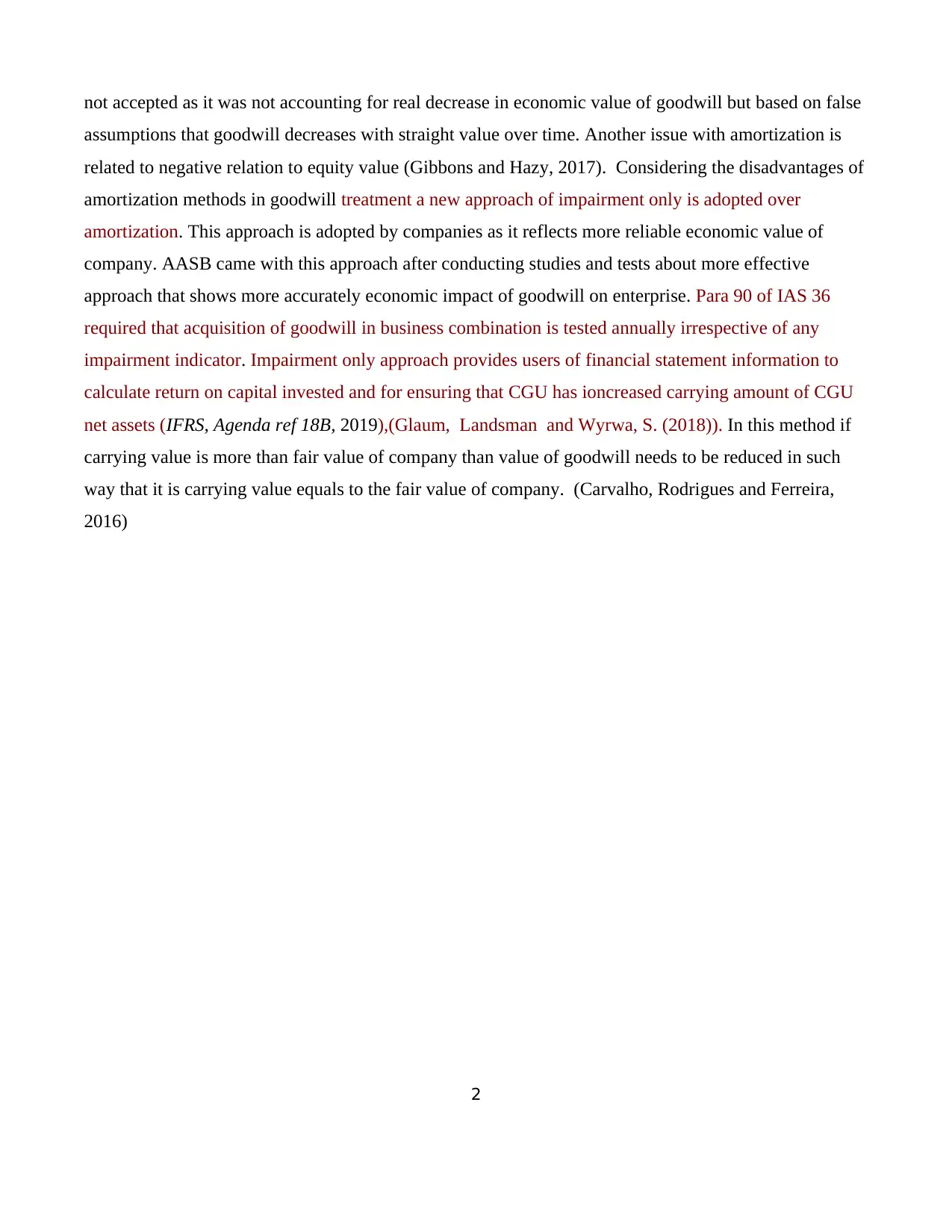
not accepted as it was not accounting for real decrease in economic value of goodwill but based on false
assumptions that goodwill decreases with straight value over time. Another issue with amortization is
related to negative relation to equity value (Gibbons and Hazy, 2017). Considering the disadvantages of
amortization methods in goodwill treatment a new approach of impairment only is adopted over
amortization. This approach is adopted by companies as it reflects more reliable economic value of
company. AASB came with this approach after conducting studies and tests about more effective
approach that shows more accurately economic impact of goodwill on enterprise. Para 90 of IAS 36
required that acquisition of goodwill in business combination is tested annually irrespective of any
impairment indicator. Impairment only approach provides users of financial statement information to
calculate return on capital invested and for ensuring that CGU has ioncreased carrying amount of CGU
net assets (IFRS, Agenda ref 18B, 2019),(Glaum, Landsman and Wyrwa, S. (2018)). In this method if
carrying value is more than fair value of company than value of goodwill needs to be reduced in such
way that it is carrying value equals to the fair value of company. (Carvalho, Rodrigues and Ferreira,
2016)
2
assumptions that goodwill decreases with straight value over time. Another issue with amortization is
related to negative relation to equity value (Gibbons and Hazy, 2017). Considering the disadvantages of
amortization methods in goodwill treatment a new approach of impairment only is adopted over
amortization. This approach is adopted by companies as it reflects more reliable economic value of
company. AASB came with this approach after conducting studies and tests about more effective
approach that shows more accurately economic impact of goodwill on enterprise. Para 90 of IAS 36
required that acquisition of goodwill in business combination is tested annually irrespective of any
impairment indicator. Impairment only approach provides users of financial statement information to
calculate return on capital invested and for ensuring that CGU has ioncreased carrying amount of CGU
net assets (IFRS, Agenda ref 18B, 2019),(Glaum, Landsman and Wyrwa, S. (2018)). In this method if
carrying value is more than fair value of company than value of goodwill needs to be reduced in such
way that it is carrying value equals to the fair value of company. (Carvalho, Rodrigues and Ferreira,
2016)
2
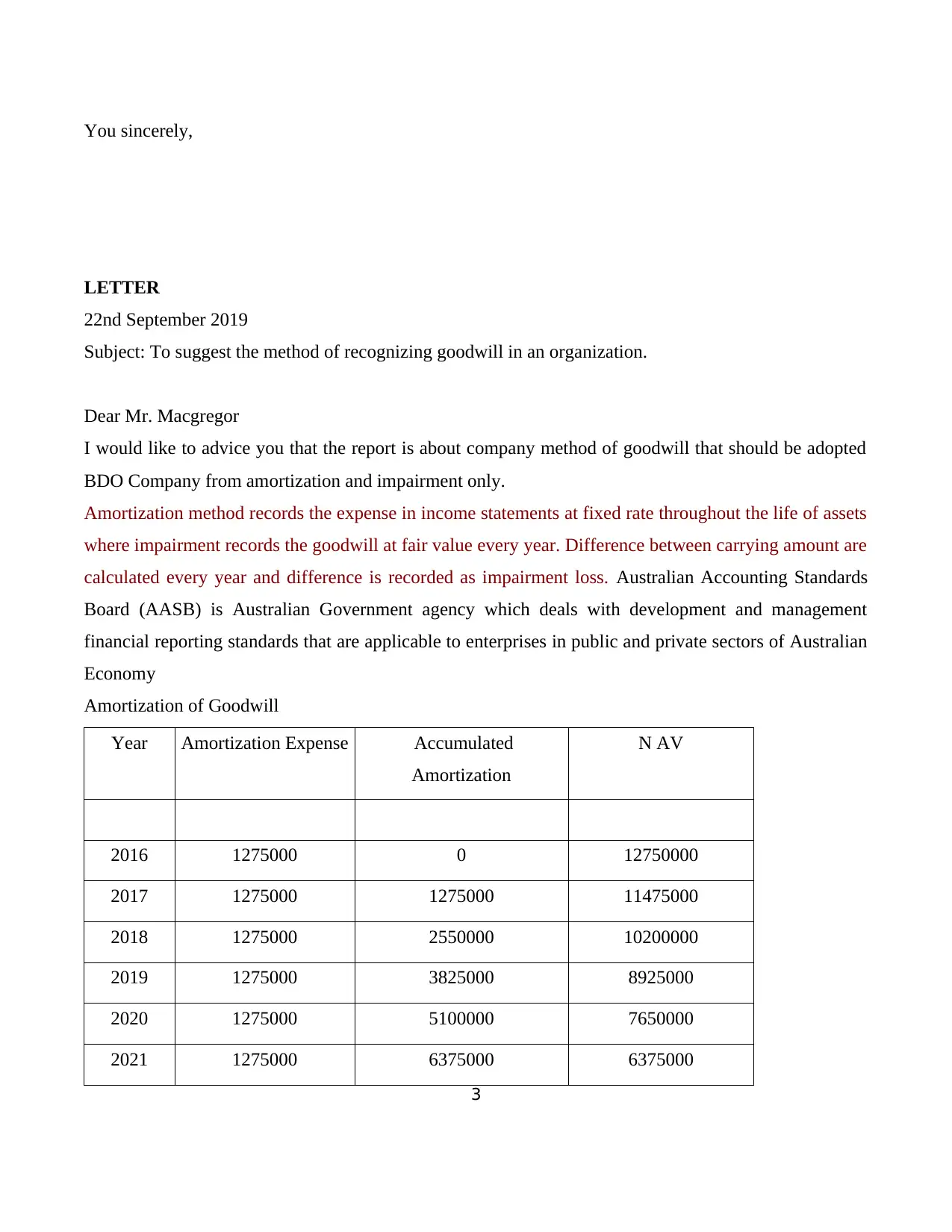
You sincerely,
LETTER
22nd September 2019
Subject: To suggest the method of recognizing goodwill in an organization.
Dear Mr. Macgregor
I would like to advice you that the report is about company method of goodwill that should be adopted
BDO Company from amortization and impairment only.
Amortization method records the expense in income statements at fixed rate throughout the life of assets
where impairment records the goodwill at fair value every year. Difference between carrying amount are
calculated every year and difference is recorded as impairment loss. Australian Accounting Standards
Board (AASB) is Australian Government agency which deals with development and management
financial reporting standards that are applicable to enterprises in public and private sectors of Australian
Economy
Amortization of Goodwill
Year Amortization Expense Accumulated
Amortization
N AV
2016 1275000 0 12750000
2017 1275000 1275000 11475000
2018 1275000 2550000 10200000
2019 1275000 3825000 8925000
2020 1275000 5100000 7650000
2021 1275000 6375000 6375000
3
LETTER
22nd September 2019
Subject: To suggest the method of recognizing goodwill in an organization.
Dear Mr. Macgregor
I would like to advice you that the report is about company method of goodwill that should be adopted
BDO Company from amortization and impairment only.
Amortization method records the expense in income statements at fixed rate throughout the life of assets
where impairment records the goodwill at fair value every year. Difference between carrying amount are
calculated every year and difference is recorded as impairment loss. Australian Accounting Standards
Board (AASB) is Australian Government agency which deals with development and management
financial reporting standards that are applicable to enterprises in public and private sectors of Australian
Economy
Amortization of Goodwill
Year Amortization Expense Accumulated
Amortization
N AV
2016 1275000 0 12750000
2017 1275000 1275000 11475000
2018 1275000 2550000 10200000
2019 1275000 3825000 8925000
2020 1275000 5100000 7650000
2021 1275000 6375000 6375000
3
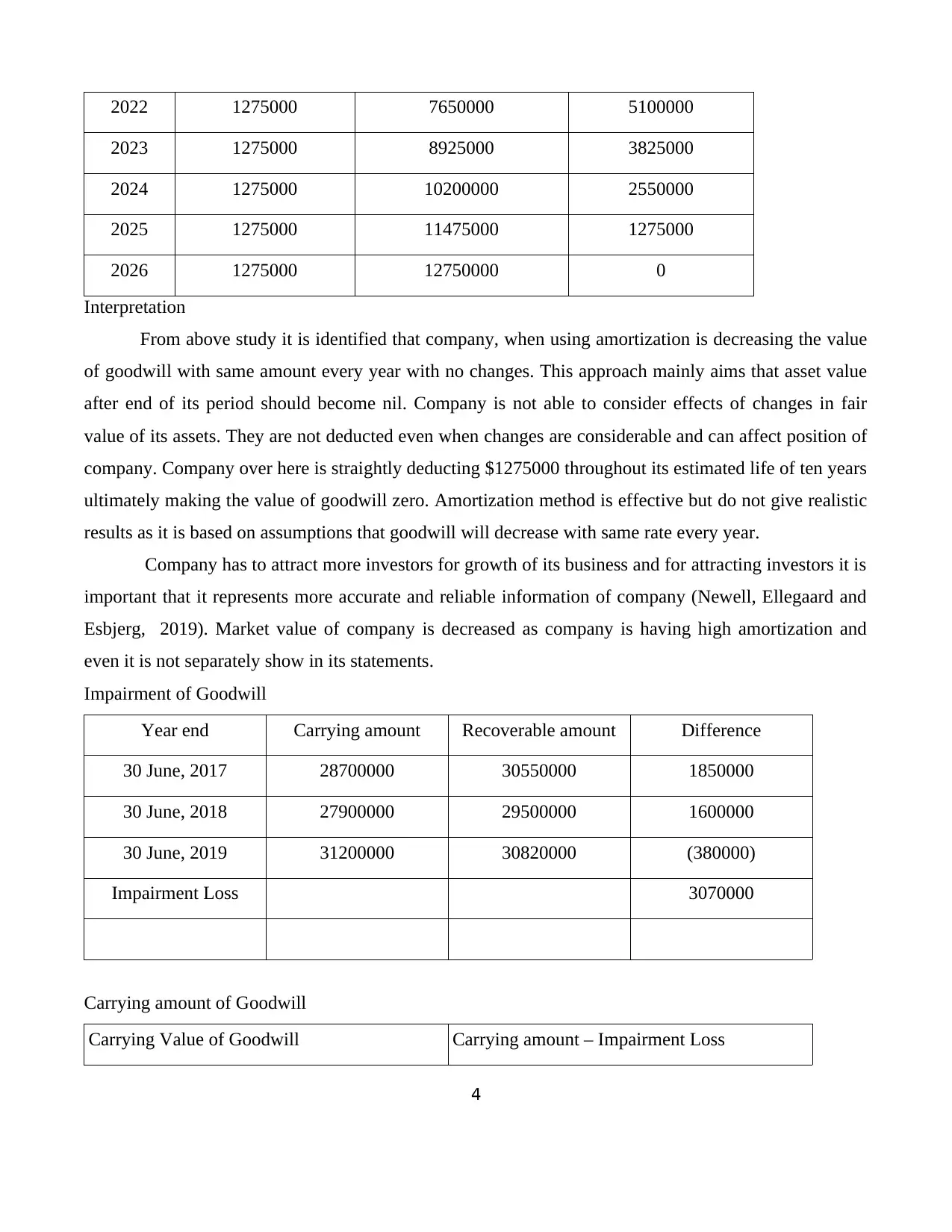
2022 1275000 7650000 5100000
2023 1275000 8925000 3825000
2024 1275000 10200000 2550000
2025 1275000 11475000 1275000
2026 1275000 12750000 0
Interpretation
From above study it is identified that company, when using amortization is decreasing the value
of goodwill with same amount every year with no changes. This approach mainly aims that asset value
after end of its period should become nil. Company is not able to consider effects of changes in fair
value of its assets. They are not deducted even when changes are considerable and can affect position of
company. Company over here is straightly deducting $1275000 throughout its estimated life of ten years
ultimately making the value of goodwill zero. Amortization method is effective but do not give realistic
results as it is based on assumptions that goodwill will decrease with same rate every year.
Company has to attract more investors for growth of its business and for attracting investors it is
important that it represents more accurate and reliable information of company (Newell, Ellegaard and
Esbjerg, 2019). Market value of company is decreased as company is having high amortization and
even it is not separately show in its statements.
Impairment of Goodwill
Year end Carrying amount Recoverable amount Difference
30 June, 2017 28700000 30550000 1850000
30 June, 2018 27900000 29500000 1600000
30 June, 2019 31200000 30820000 (380000)
Impairment Loss 3070000
Carrying amount of Goodwill
Carrying Value of Goodwill Carrying amount – Impairment Loss
4
2023 1275000 8925000 3825000
2024 1275000 10200000 2550000
2025 1275000 11475000 1275000
2026 1275000 12750000 0
Interpretation
From above study it is identified that company, when using amortization is decreasing the value
of goodwill with same amount every year with no changes. This approach mainly aims that asset value
after end of its period should become nil. Company is not able to consider effects of changes in fair
value of its assets. They are not deducted even when changes are considerable and can affect position of
company. Company over here is straightly deducting $1275000 throughout its estimated life of ten years
ultimately making the value of goodwill zero. Amortization method is effective but do not give realistic
results as it is based on assumptions that goodwill will decrease with same rate every year.
Company has to attract more investors for growth of its business and for attracting investors it is
important that it represents more accurate and reliable information of company (Newell, Ellegaard and
Esbjerg, 2019). Market value of company is decreased as company is having high amortization and
even it is not separately show in its statements.
Impairment of Goodwill
Year end Carrying amount Recoverable amount Difference
30 June, 2017 28700000 30550000 1850000
30 June, 2018 27900000 29500000 1600000
30 June, 2019 31200000 30820000 (380000)
Impairment Loss 3070000
Carrying amount of Goodwill
Carrying Value of Goodwill Carrying amount – Impairment Loss
4
Secure Best Marks with AI Grader
Need help grading? Try our AI Grader for instant feedback on your assignments.
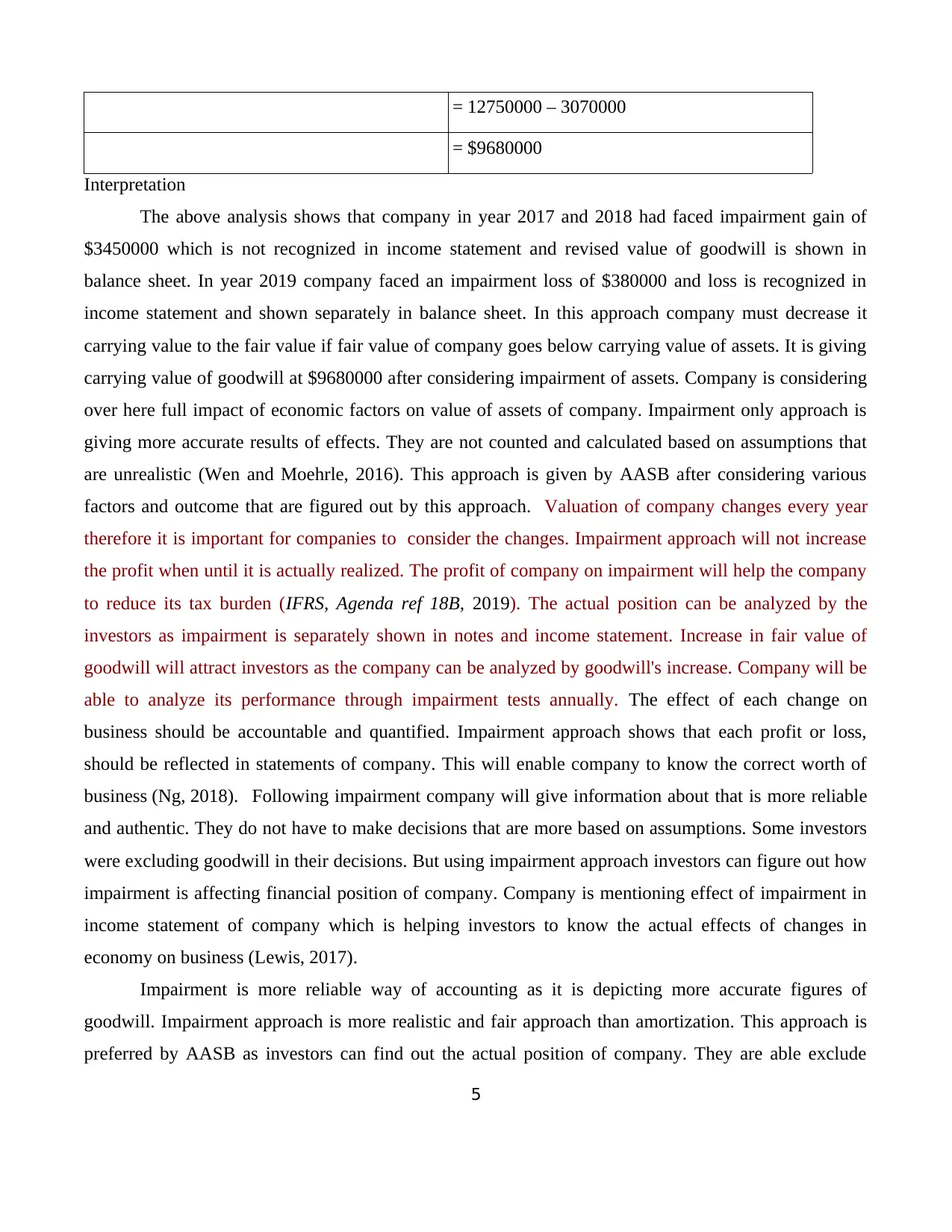
= 12750000 – 3070000
= $9680000
Interpretation
The above analysis shows that company in year 2017 and 2018 had faced impairment gain of
$3450000 which is not recognized in income statement and revised value of goodwill is shown in
balance sheet. In year 2019 company faced an impairment loss of $380000 and loss is recognized in
income statement and shown separately in balance sheet. In this approach company must decrease it
carrying value to the fair value if fair value of company goes below carrying value of assets. It is giving
carrying value of goodwill at $9680000 after considering impairment of assets. Company is considering
over here full impact of economic factors on value of assets of company. Impairment only approach is
giving more accurate results of effects. They are not counted and calculated based on assumptions that
are unrealistic (Wen and Moehrle, 2016). This approach is given by AASB after considering various
factors and outcome that are figured out by this approach. Valuation of company changes every year
therefore it is important for companies to consider the changes. Impairment approach will not increase
the profit when until it is actually realized. The profit of company on impairment will help the company
to reduce its tax burden (IFRS, Agenda ref 18B, 2019). The actual position can be analyzed by the
investors as impairment is separately shown in notes and income statement. Increase in fair value of
goodwill will attract investors as the company can be analyzed by goodwill's increase. Company will be
able to analyze its performance through impairment tests annually. The effect of each change on
business should be accountable and quantified. Impairment approach shows that each profit or loss,
should be reflected in statements of company. This will enable company to know the correct worth of
business (Ng, 2018). Following impairment company will give information about that is more reliable
and authentic. They do not have to make decisions that are more based on assumptions. Some investors
were excluding goodwill in their decisions. But using impairment approach investors can figure out how
impairment is affecting financial position of company. Company is mentioning effect of impairment in
income statement of company which is helping investors to know the actual effects of changes in
economy on business (Lewis, 2017).
Impairment is more reliable way of accounting as it is depicting more accurate figures of
goodwill. Impairment approach is more realistic and fair approach than amortization. This approach is
preferred by AASB as investors can find out the actual position of company. They are able exclude
5
= $9680000
Interpretation
The above analysis shows that company in year 2017 and 2018 had faced impairment gain of
$3450000 which is not recognized in income statement and revised value of goodwill is shown in
balance sheet. In year 2019 company faced an impairment loss of $380000 and loss is recognized in
income statement and shown separately in balance sheet. In this approach company must decrease it
carrying value to the fair value if fair value of company goes below carrying value of assets. It is giving
carrying value of goodwill at $9680000 after considering impairment of assets. Company is considering
over here full impact of economic factors on value of assets of company. Impairment only approach is
giving more accurate results of effects. They are not counted and calculated based on assumptions that
are unrealistic (Wen and Moehrle, 2016). This approach is given by AASB after considering various
factors and outcome that are figured out by this approach. Valuation of company changes every year
therefore it is important for companies to consider the changes. Impairment approach will not increase
the profit when until it is actually realized. The profit of company on impairment will help the company
to reduce its tax burden (IFRS, Agenda ref 18B, 2019). The actual position can be analyzed by the
investors as impairment is separately shown in notes and income statement. Increase in fair value of
goodwill will attract investors as the company can be analyzed by goodwill's increase. Company will be
able to analyze its performance through impairment tests annually. The effect of each change on
business should be accountable and quantified. Impairment approach shows that each profit or loss,
should be reflected in statements of company. This will enable company to know the correct worth of
business (Ng, 2018). Following impairment company will give information about that is more reliable
and authentic. They do not have to make decisions that are more based on assumptions. Some investors
were excluding goodwill in their decisions. But using impairment approach investors can figure out how
impairment is affecting financial position of company. Company is mentioning effect of impairment in
income statement of company which is helping investors to know the actual effects of changes in
economy on business (Lewis, 2017).
Impairment is more reliable way of accounting as it is depicting more accurate figures of
goodwill. Impairment approach is more realistic and fair approach than amortization. This approach is
preferred by AASB as investors can find out the actual position of company. They are able exclude
5
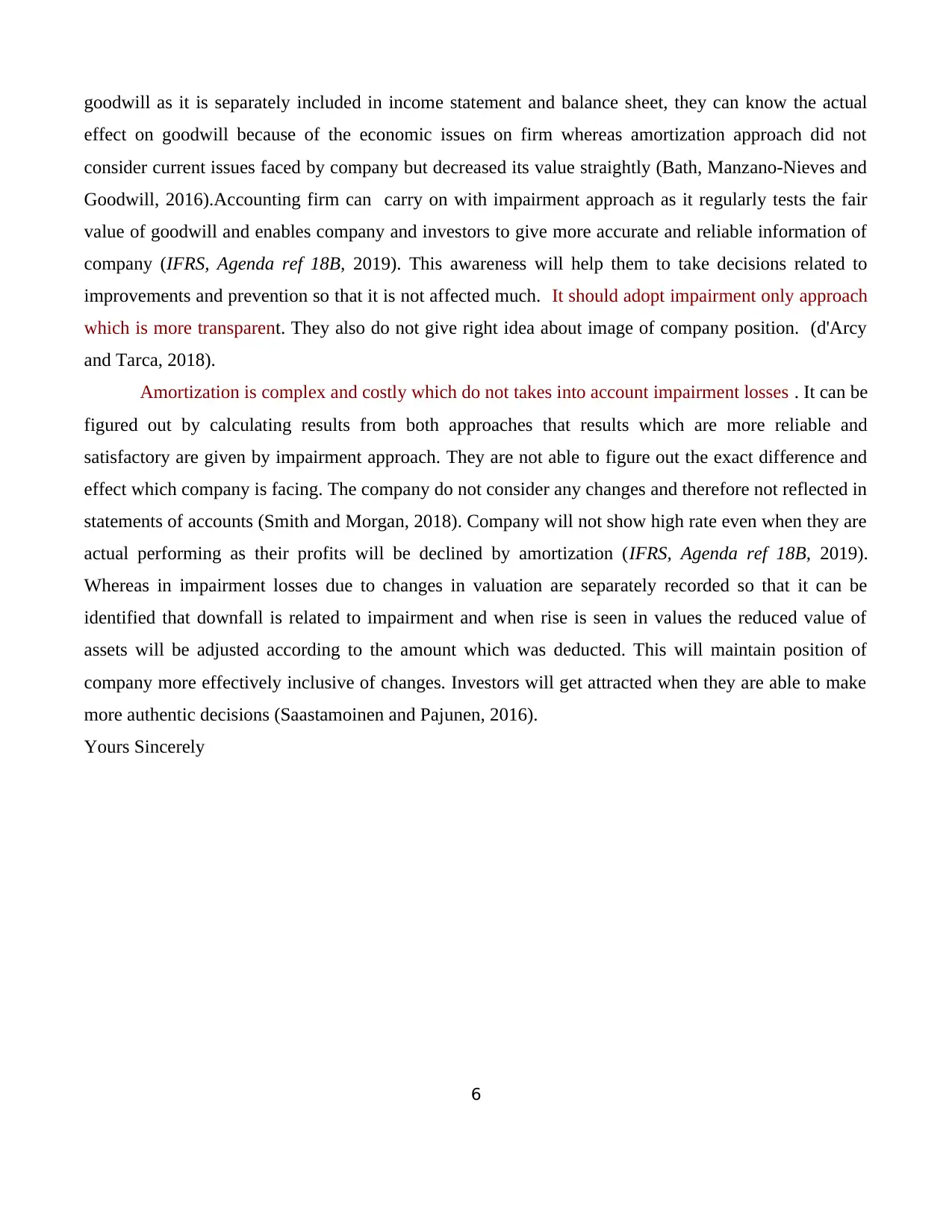
goodwill as it is separately included in income statement and balance sheet, they can know the actual
effect on goodwill because of the economic issues on firm whereas amortization approach did not
consider current issues faced by company but decreased its value straightly (Bath, Manzano-Nieves and
Goodwill, 2016).Accounting firm can carry on with impairment approach as it regularly tests the fair
value of goodwill and enables company and investors to give more accurate and reliable information of
company (IFRS, Agenda ref 18B, 2019). This awareness will help them to take decisions related to
improvements and prevention so that it is not affected much. It should adopt impairment only approach
which is more transparent. They also do not give right idea about image of company position. (d'Arcy
and Tarca, 2018).
Amortization is complex and costly which do not takes into account impairment losses . It can be
figured out by calculating results from both approaches that results which are more reliable and
satisfactory are given by impairment approach. They are not able to figure out the exact difference and
effect which company is facing. The company do not consider any changes and therefore not reflected in
statements of accounts (Smith and Morgan, 2018). Company will not show high rate even when they are
actual performing as their profits will be declined by amortization (IFRS, Agenda ref 18B, 2019).
Whereas in impairment losses due to changes in valuation are separately recorded so that it can be
identified that downfall is related to impairment and when rise is seen in values the reduced value of
assets will be adjusted according to the amount which was deducted. This will maintain position of
company more effectively inclusive of changes. Investors will get attracted when they are able to make
more authentic decisions (Saastamoinen and Pajunen, 2016).
Yours Sincerely
6
effect on goodwill because of the economic issues on firm whereas amortization approach did not
consider current issues faced by company but decreased its value straightly (Bath, Manzano-Nieves and
Goodwill, 2016).Accounting firm can carry on with impairment approach as it regularly tests the fair
value of goodwill and enables company and investors to give more accurate and reliable information of
company (IFRS, Agenda ref 18B, 2019). This awareness will help them to take decisions related to
improvements and prevention so that it is not affected much. It should adopt impairment only approach
which is more transparent. They also do not give right idea about image of company position. (d'Arcy
and Tarca, 2018).
Amortization is complex and costly which do not takes into account impairment losses . It can be
figured out by calculating results from both approaches that results which are more reliable and
satisfactory are given by impairment approach. They are not able to figure out the exact difference and
effect which company is facing. The company do not consider any changes and therefore not reflected in
statements of accounts (Smith and Morgan, 2018). Company will not show high rate even when they are
actual performing as their profits will be declined by amortization (IFRS, Agenda ref 18B, 2019).
Whereas in impairment losses due to changes in valuation are separately recorded so that it can be
identified that downfall is related to impairment and when rise is seen in values the reduced value of
assets will be adjusted according to the amount which was deducted. This will maintain position of
company more effectively inclusive of changes. Investors will get attracted when they are able to make
more authentic decisions (Saastamoinen and Pajunen, 2016).
Yours Sincerely
6
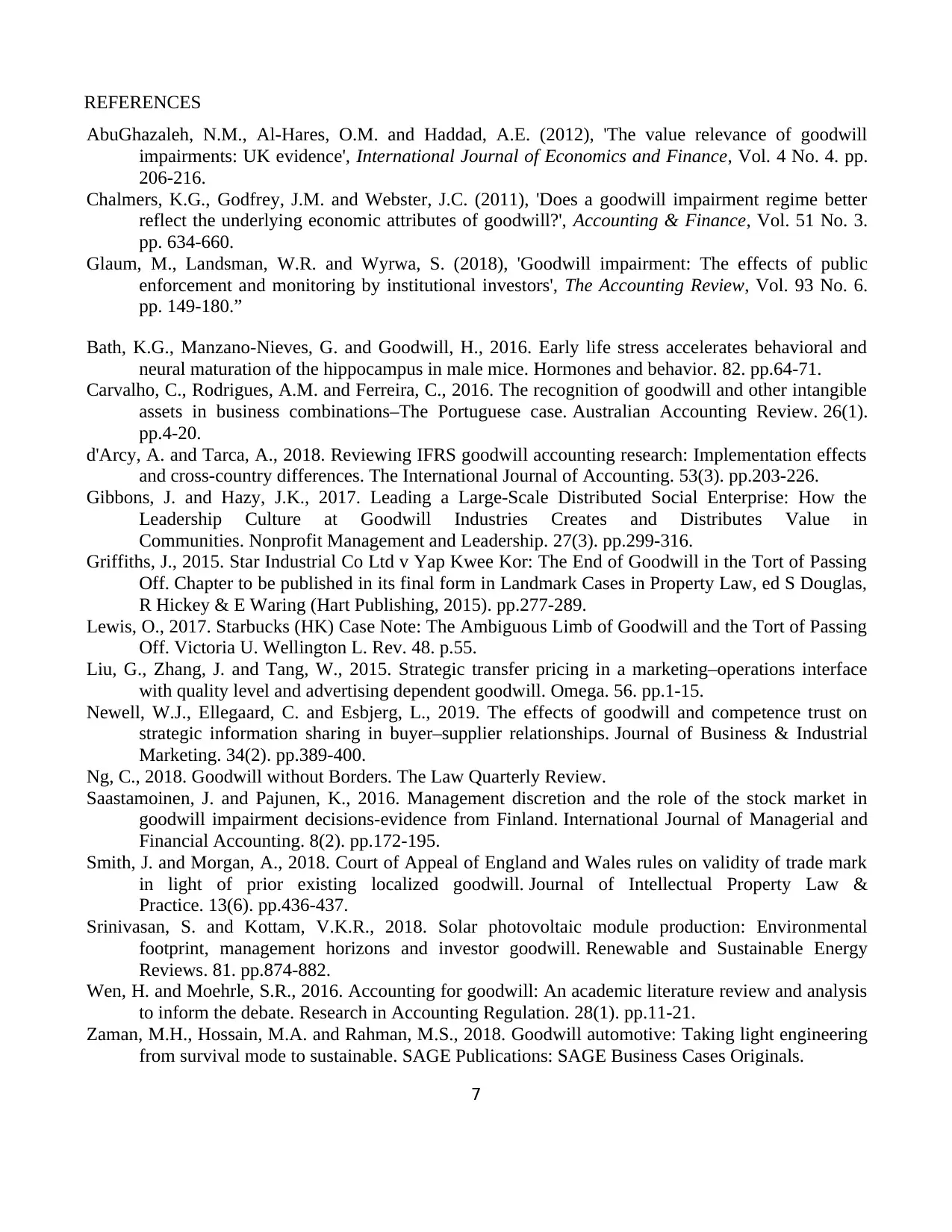
REFERENCES
AbuGhazaleh, N.M., Al-Hares, O.M. and Haddad, A.E. (2012), 'The value relevance of goodwill
impairments: UK evidence', International Journal of Economics and Finance, Vol. 4 No. 4. pp.
206-216.
Chalmers, K.G., Godfrey, J.M. and Webster, J.C. (2011), 'Does a goodwill impairment regime better
reflect the underlying economic attributes of goodwill?', Accounting & Finance, Vol. 51 No. 3.
pp. 634-660.
Glaum, M., Landsman, W.R. and Wyrwa, S. (2018), 'Goodwill impairment: The effects of public
enforcement and monitoring by institutional investors', The Accounting Review, Vol. 93 No. 6.
pp. 149-180.”
Bath, K.G., Manzano-Nieves, G. and Goodwill, H., 2016. Early life stress accelerates behavioral and
neural maturation of the hippocampus in male mice. Hormones and behavior. 82. pp.64-71.
Carvalho, C., Rodrigues, A.M. and Ferreira, C., 2016. The recognition of goodwill and other intangible
assets in business combinations–The Portuguese case. Australian Accounting Review. 26(1).
pp.4-20.
d'Arcy, A. and Tarca, A., 2018. Reviewing IFRS goodwill accounting research: Implementation effects
and cross-country differences. The International Journal of Accounting. 53(3). pp.203-226.
Gibbons, J. and Hazy, J.K., 2017. Leading a Large‐Scale Distributed Social Enterprise: How the
Leadership Culture at Goodwill Industries Creates and Distributes Value in
Communities. Nonprofit Management and Leadership. 27(3). pp.299-316.
Griffiths, J., 2015. Star Industrial Co Ltd v Yap Kwee Kor: The End of Goodwill in the Tort of Passing
Off. Chapter to be published in its final form in Landmark Cases in Property Law, ed S Douglas,
R Hickey & E Waring (Hart Publishing, 2015). pp.277-289.
Lewis, O., 2017. Starbucks (HK) Case Note: The Ambiguous Limb of Goodwill and the Tort of Passing
Off. Victoria U. Wellington L. Rev. 48. p.55.
Liu, G., Zhang, J. and Tang, W., 2015. Strategic transfer pricing in a marketing–operations interface
with quality level and advertising dependent goodwill. Omega. 56. pp.1-15.
Newell, W.J., Ellegaard, C. and Esbjerg, L., 2019. The effects of goodwill and competence trust on
strategic information sharing in buyer–supplier relationships. Journal of Business & Industrial
Marketing. 34(2). pp.389-400.
Ng, C., 2018. Goodwill without Borders. The Law Quarterly Review.
Saastamoinen, J. and Pajunen, K., 2016. Management discretion and the role of the stock market in
goodwill impairment decisions-evidence from Finland. International Journal of Managerial and
Financial Accounting. 8(2). pp.172-195.
Smith, J. and Morgan, A., 2018. Court of Appeal of England and Wales rules on validity of trade mark
in light of prior existing localized goodwill. Journal of Intellectual Property Law &
Practice. 13(6). pp.436-437.
Srinivasan, S. and Kottam, V.K.R., 2018. Solar photovoltaic module production: Environmental
footprint, management horizons and investor goodwill. Renewable and Sustainable Energy
Reviews. 81. pp.874-882.
Wen, H. and Moehrle, S.R., 2016. Accounting for goodwill: An academic literature review and analysis
to inform the debate. Research in Accounting Regulation. 28(1). pp.11-21.
Zaman, M.H., Hossain, M.A. and Rahman, M.S., 2018. Goodwill automotive: Taking light engineering
from survival mode to sustainable. SAGE Publications: SAGE Business Cases Originals.
7
AbuGhazaleh, N.M., Al-Hares, O.M. and Haddad, A.E. (2012), 'The value relevance of goodwill
impairments: UK evidence', International Journal of Economics and Finance, Vol. 4 No. 4. pp.
206-216.
Chalmers, K.G., Godfrey, J.M. and Webster, J.C. (2011), 'Does a goodwill impairment regime better
reflect the underlying economic attributes of goodwill?', Accounting & Finance, Vol. 51 No. 3.
pp. 634-660.
Glaum, M., Landsman, W.R. and Wyrwa, S. (2018), 'Goodwill impairment: The effects of public
enforcement and monitoring by institutional investors', The Accounting Review, Vol. 93 No. 6.
pp. 149-180.”
Bath, K.G., Manzano-Nieves, G. and Goodwill, H., 2016. Early life stress accelerates behavioral and
neural maturation of the hippocampus in male mice. Hormones and behavior. 82. pp.64-71.
Carvalho, C., Rodrigues, A.M. and Ferreira, C., 2016. The recognition of goodwill and other intangible
assets in business combinations–The Portuguese case. Australian Accounting Review. 26(1).
pp.4-20.
d'Arcy, A. and Tarca, A., 2018. Reviewing IFRS goodwill accounting research: Implementation effects
and cross-country differences. The International Journal of Accounting. 53(3). pp.203-226.
Gibbons, J. and Hazy, J.K., 2017. Leading a Large‐Scale Distributed Social Enterprise: How the
Leadership Culture at Goodwill Industries Creates and Distributes Value in
Communities. Nonprofit Management and Leadership. 27(3). pp.299-316.
Griffiths, J., 2015. Star Industrial Co Ltd v Yap Kwee Kor: The End of Goodwill in the Tort of Passing
Off. Chapter to be published in its final form in Landmark Cases in Property Law, ed S Douglas,
R Hickey & E Waring (Hart Publishing, 2015). pp.277-289.
Lewis, O., 2017. Starbucks (HK) Case Note: The Ambiguous Limb of Goodwill and the Tort of Passing
Off. Victoria U. Wellington L. Rev. 48. p.55.
Liu, G., Zhang, J. and Tang, W., 2015. Strategic transfer pricing in a marketing–operations interface
with quality level and advertising dependent goodwill. Omega. 56. pp.1-15.
Newell, W.J., Ellegaard, C. and Esbjerg, L., 2019. The effects of goodwill and competence trust on
strategic information sharing in buyer–supplier relationships. Journal of Business & Industrial
Marketing. 34(2). pp.389-400.
Ng, C., 2018. Goodwill without Borders. The Law Quarterly Review.
Saastamoinen, J. and Pajunen, K., 2016. Management discretion and the role of the stock market in
goodwill impairment decisions-evidence from Finland. International Journal of Managerial and
Financial Accounting. 8(2). pp.172-195.
Smith, J. and Morgan, A., 2018. Court of Appeal of England and Wales rules on validity of trade mark
in light of prior existing localized goodwill. Journal of Intellectual Property Law &
Practice. 13(6). pp.436-437.
Srinivasan, S. and Kottam, V.K.R., 2018. Solar photovoltaic module production: Environmental
footprint, management horizons and investor goodwill. Renewable and Sustainable Energy
Reviews. 81. pp.874-882.
Wen, H. and Moehrle, S.R., 2016. Accounting for goodwill: An academic literature review and analysis
to inform the debate. Research in Accounting Regulation. 28(1). pp.11-21.
Zaman, M.H., Hossain, M.A. and Rahman, M.S., 2018. Goodwill automotive: Taking light engineering
from survival mode to sustainable. SAGE Publications: SAGE Business Cases Originals.
7
Paraphrase This Document
Need a fresh take? Get an instant paraphrase of this document with our AI Paraphraser
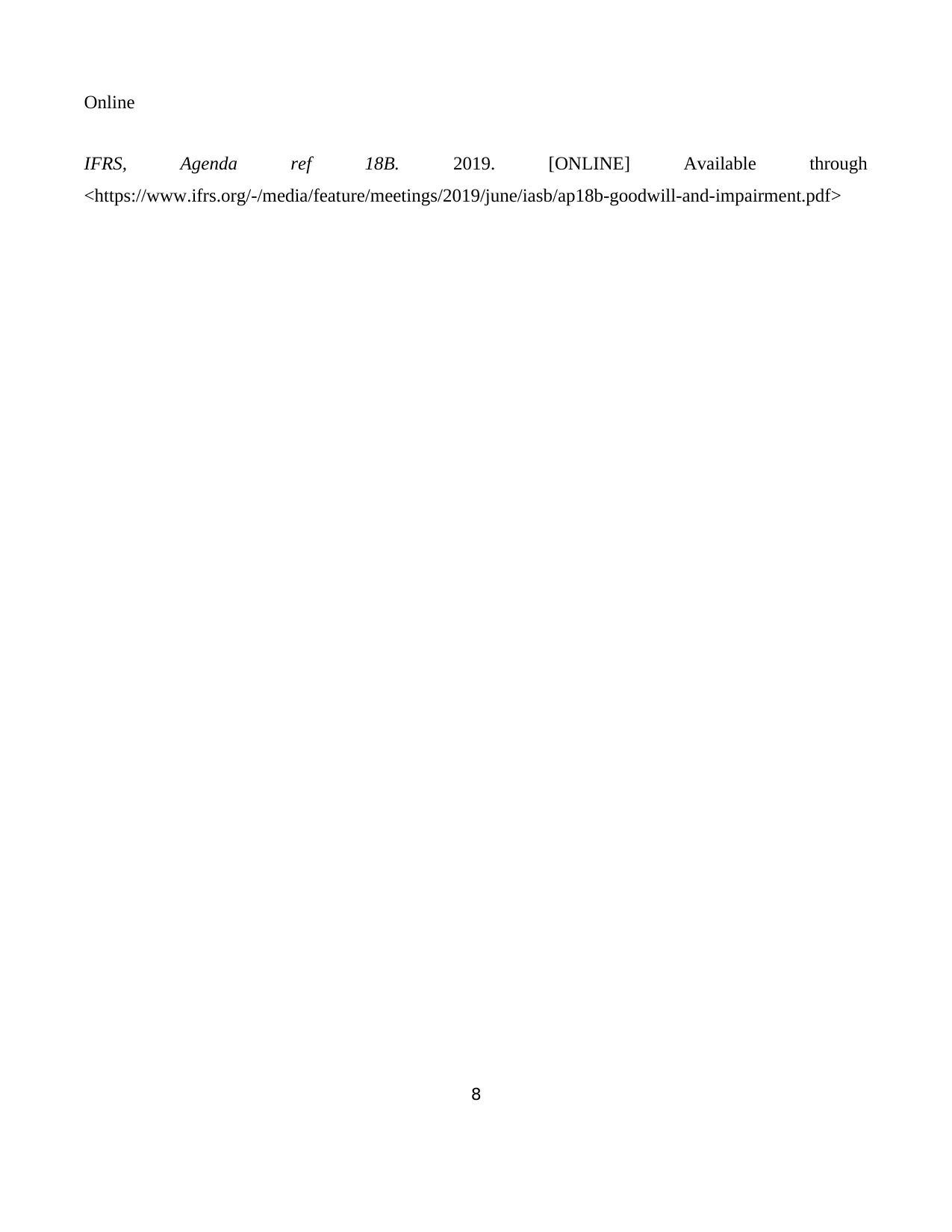
Online
IFRS, Agenda ref 18B. 2019. [ONLINE] Available through
<https://www.ifrs.org/-/media/feature/meetings/2019/june/iasb/ap18b-goodwill-and-impairment.pdf>
8
IFRS, Agenda ref 18B. 2019. [ONLINE] Available through
<https://www.ifrs.org/-/media/feature/meetings/2019/june/iasb/ap18b-goodwill-and-impairment.pdf>
8
1 out of 8
Related Documents
Your All-in-One AI-Powered Toolkit for Academic Success.
+13062052269
info@desklib.com
Available 24*7 on WhatsApp / Email
![[object Object]](/_next/static/media/star-bottom.7253800d.svg)
Unlock your academic potential
© 2024 | Zucol Services PVT LTD | All rights reserved.




